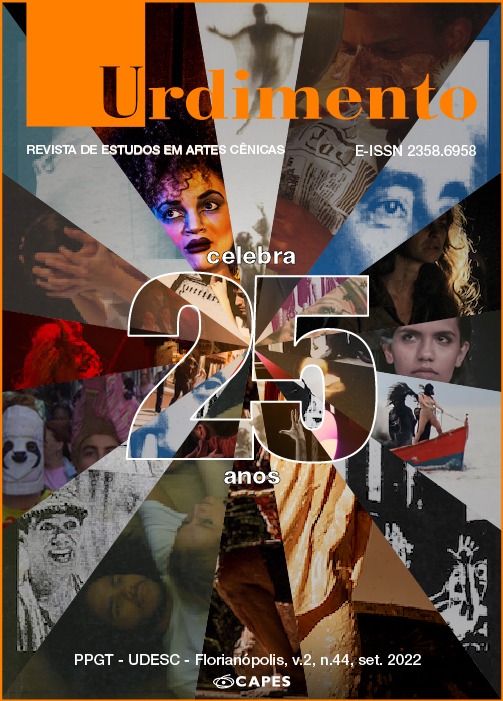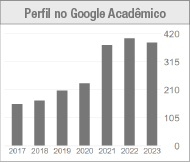O feminicídio como material: explorando a narrativa dramatúrgica
DOI:
https://doi.org/10.5965/1414573102442022e0301Palavras-chave:
Dramaturgia, Feminmicídio, Pedagogia teatral, Processos criativos, EscritaResumo
Nesse artigo procuramos apresentar e problematizar duas questões relacionadas entre si. A primeira questão é referente às estratégias e dinâmicas para o ensino ou aperfeiçoamento da escrita teatral, isto é, uma contribuição para uma pedagogia da dramaturgia. A segunda questão se traduz na apresentação, seguida de comentários, de um fragmento de um texto que se deseja teatral. O texto em questão, Hipólito, encontra-se em processo de escrita e aqui apresentamos uma reflexão parcial sobre o processo de sua redação encaminhado por nós. Portanto, nosso artigo não apresenta conclusões finais, permanecendo em “aberto” até que o processo de escrita termine e possamos julgar melhor esse texto desde seu verdadeiro lugar de enunciação que é o espaço teatral.
Downloads
Referências
AGAMBEN, Giorgio. Profanações. São Paulo: Boitempo, 2007.
ABREU, Luís Alberto de. A personagem contemporânea: uma hipótese. Sala Preta, São Paulo, v.1, n.1 p. 61-67, jan. 2001. Acesso em: 12 maio 2022.
ABREU, Luís Alberto de. Eppur si muove! Vintém, São Paulo, v.2, p. 26 - 31, 01 jun. 1998. Acesso em: 12 maio 2022.
ABREU, Luís Alberto de. A restauração da narrativa.· O Percevejo, Rio de Janeiro X.9, p. 115-125, 2000. Acesso em: 15 maio 2022.
ABREU, Luis Alberto de. A Dramaturgia e as Novas Configurações do Espetáculo. Caderno de Registros Macu. Dossiê Tecendo Vidas Com o Fio do Texto. São Paulo, v. 8, p. 6-11, 2016. Acesso em: 15 maio 2022.
BAUMGÄRTEL, Stephan Arnulf; MEDEIROS, Elen de; SANCHES, João. Avatares da peça-bem-feita na dramaturgia brasileira contemporânea. Revista Cena, Porto Alegre, n. 27, p. 122-136, jan./abr. 2019. Acesso em: 20 abr. 2022. DOI: 10.22456/2236-3254.88658.
BRITO, Rubens José de Souza. Dos Peões ao Rei: o teatro épi-co-dramático de Luís Alberto de Abreu. 1999. Tese (Doutorado em Artes Cênicas) - Escola de Comunicações e Artes da Universidade de São Paulo, São Paulo, 1999.
CAMPOS, Flavio de. Roteiro de Cinema e Televisão: A arte ea técnica de imaginar, perceber e narrar uma estória. Rio de Janeiro: Jorge. Zahar, 2007.
CIXOUS, Hélène. O riso da medusa. Trad. Natália Guerellus e Raísa França Bastos. PREF. Frédéric Regard. POSF. Flavia Trocoli. Bazar do Tempo; 1ª edição, 2022.
LEMAHIEU, Daniel. Faire faire la poésie dramatique. Revue d'études théâtrales, Louvain-la Neuve. Belgique, n.1, p. 51- 62, 1992. “Théâtre et université”.
PALLOTTINI, Renata. Introdução à dramaturgia. São Paulo: Ática, 1988.
RODRIGUES, Vitinho; FLECK Tomás; COSTA, Soraia; SOARES, Rodrigo; CONDE, Letícia; MARSIGLIA, Ivan; PASSARELLI, Dante; FUNEZ, Daniela; FERRAZANO, Camila; MOFEOLI, Belise; LOPEZ, Ana Paula; CARNEIRO, Amanda. Núcleo de Dramaturgia SESI 12ª Turma. São Paulo: SESI-SP Editora, 2022.
SÁNCHEZ, José Antonio. A pesquisa artística e a arte dos dispositivos. Questão de Crítica. Revista eletrônica de críticas e estudos teatrais, Rio de Janeiro, v. 8, n. 65, p.322-327, 2015. Acesso em: 19 de maio. 2022.
SARRAZAC, Jean-Pierre. O futuro do drama. Porto: Campo das Letras, 2002.
SARRAZAC, Jean-Pierre. (Org). Léxico do drama moderno e contemporâneo. São Paulo: Cosac Naify, 2012.
SINISTERRA, José Sanchis. Da Literatura ao Palco: Dramaturgia de textos narrativos. São Paulo: É Realizações, 2016.
SOUZA, Cláudia. et al. Escrevendo o presente: 10 anos de núcleo de dramaturgia SESI Paraná. 1. ed. Curitiba: Rumo de Cultura: SESI Cultura Paraná, 2020.
Publicado
Como Citar
Edição
Seção
Licença
Copyright (c) 2022 Urdimento - Revista de Estudos em Artes Cênicas

Este trabalho está licenciado sob uma licença Creative Commons Attribution 4.0 International License.
Declaração de Direito Autoral
Os leitores são livres para transferir, imprimir e utilizar os artigos publicados na Revista, desde que haja sempre menção explícita ao(s) autor (es) e à Urdimentoe que não haja qualquer alteração no trabalho original. Qualquer outro uso dos textos precisa ser aprovado pelo(s) autor (es) e pela Revista. Ao submeter um artigo à Urdimento e tê-lo aprovado os autores concordam em ceder, sem remuneração, os seguintes direitos à Revista: os direitos de primeira publicação e a permissão para que a Revista redistribua esse artigo e seus meta dados aos serviços de indexação e referência que seus editores julguem apropriados.
Este periódico utiliza uma Licença de Atribuição Creative Commons– (CC BY 4.0)




